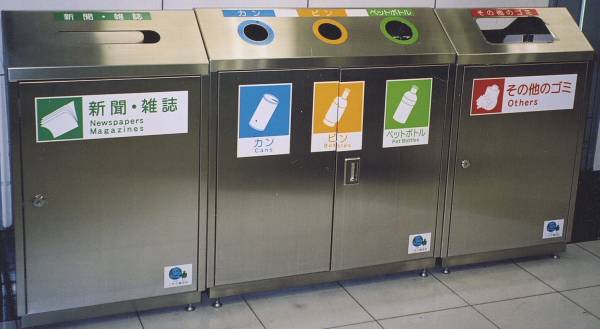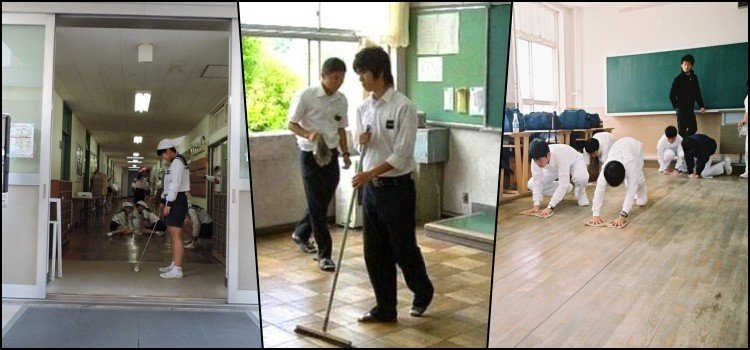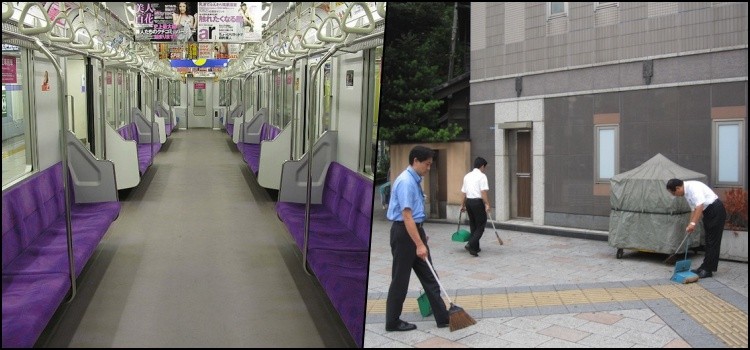Is there pollution in Japan? How do the Japanese get rid of their garbage? Is Japan a clean and green country? In this guide we are going to talk about everything about garbage separation, garbage collection and garbage recycling in Japan, as well as some facts about Japanese cleaning.
Talking about sorting, collecting and recycling garbage in Japan is a very complex subject. There are endless rules related to this matter, each city and province has its rules for sorting and collecting garbage. Although each location has its different rules, there is a pattern in this matter.
In Japan, each person is responsible for separating their garbage, and throwing it away in the correct place. There is a culture of cleanliness that makes Japan always clean. Before we talk about collection, let's talk about this culture of cleanliness.

Índice de Conteúdo
Why Japan is Clean and Green
Japan is a small island with over 127 million inhabitants. There are thousands of factories and industries and yet the country is full of green fields and ecologically clean. Meanwhile, several countries with much more space than Japan, have totally polluted cities and almost no green.
Of course we all face environmental problems, Japan also faced problems with waste recycling and radiation from power plants. However, Japan is still a very clean and green country. He keeps most of his cities and mountains clean, full of trees and green.
The main factor that keeps Japan always clean is the culture of Cleaning. This culture is why foreign countries are shown on television when the Japanese do a simple act of cleaning, which should be everyone's obligation.
The culture of graffiti on walls is also rare in Japan, and when they do it looks more like a work of art than vandalism. The culture of keeping everything tidy and clean comes from childhood, where children are responsible for cleaning their own school.
they not only clean the school as well as planting trees and vegetation, taking care of animals and collecting garbage from the neighborhood. The seriousness in cleaning makes the population aware of their actions and responsibilities, making them think twice before making a mess.
Incentives for collection in Japan
Organization is necessary when it comes to cleaning up the environment. The Japanese recycle most of their garbage, and for that to happen they need to separate them into different types and dispose of them on the correct days.
Organization is the key to success
There are many rules on how to pack garbage and collection for recycling that varies by municipality. Anyone who tries to get dirty or disobey the rules can end up paying dearly.
Plastic bags, and even labels that are used to recycle large waste, come at a cost. Those who disobey the rules of separation, collection and recycling are chipped by paying high fines that can reach up to 250 thousand reais.

Examples of a Clean Japan
It is common for you to walk down the street and see a group of people cleaning the neighborhood, this is because adults are invited to participate in the cleaning of the neighborhood that happens regularly. Some participate in cleaning even tidy before going to work.
Although it's not mandatory, many feel obligated to help and keep their neighborhood clean. And it's not just about collecting garbage and sweeping the streets, there are activities like regulating plants, cutting herbs and grass and others.
While in many countries there is a custom of hiring maids to take care of cleaning. Most Japanese prefer to keep their area and house clean on their own.
They like to clean and feel satisfied to maintain a clean environment, this results in positive habits in their lives. This culture of always keeping things clean helps not just the person but the next. We can see how clean public transport is, with no chewing gum stuck to chairs or rubbish thrown on the floor.

Japan is continually promoting clean technology and other recycling services to keep their country clean. Being aware of the environment is crucial for the Japanese people.
They really put emphasis on the community rather than the individual. If one person makes a mess in the neighborhood, it is normal for several people to help clean up. They don't think: I'm not the one who messed it up so screw it.
The streets, cities and houses of Japan are neat and comfortable to live in. Japan's cleanliness is unparalleled and supported by different communities who want to see the world clean. Of course, this is a constant struggle, and it needs the collaboration of the entire population to work.
How does garbage separation work in Japan?
In most cities, garbage must be taken to designated collection points, on the designated day until 8:30 am. The day to throw the garbage can vary even according to the neighborhood.
To make it easier, the city hall or neighborhood is responsible for helping, and delivering a manual giving all the details of how the garbage should be thrown away. You can find this information on the internet by browsing the city's website.
Each location has its unique clear or semi-transparent plastic bags. Garbage is divided into infinite categories, and sometimes it is necessary to separate the garbage from the garbage. Even the caps need to be separated for recycling.
Some objects should be split plastic from paper and the like. So each material goes to the correct place.
The article is still halfway through, but we recommend also reading:
Types of garbage in Japan
We know that garbage is categorized and separated into many types. Each type of garbage has its designated day.
combustible garbage – Includes leftover food, wood, non-recyclable leather material, paper, kitchen waste, etc. Collection is usually done twice a week.
trash Plastic – PVC film, bags of rice, biscuit, bread and others, “tray”obento”, egg pack, polyethylene, etc. Collection is usually done once a week.
breakable waste – Light bulb (incandescent), mercury-free battery, toy, clock, radio, digital thermometer, electric toaster, thermos, hair dryer, disposable plaster (kairo), rubber boot, stuffed animal, mirror, metallic material that does not fit in the collection box for glass and cans, electrical products that are not considered large-scale waste, etc. Collection is usually done 1 time per month.
Big Garbage – Specific items: microwave, rug, mattress, blanket, bed, table, chair, bicycle, furniture in general, etc. Collection is done individually and is charged.
There are other types of garbage, sometimes it is necessary to separate the cans, glasses, etc. As I said, each city hall usually separates them differently, and they provide a booklet explaining this separation.
Did you know? in Japan the Garbage cans or dumpsters are quite rare, then you need to carry your snack trash, which usually are well packed, to the nearest convenience store or to your home.
recycling in japan
Recycling in Japan is called Risaikuru [リサイクル] based on the Japanese Packaging and Container Recycling Act. Plastic, paper, PET bottles, aluminum and glass are recycled.
Some believe that all of Japan's garbage is recycled, but this is a mistake. Only about 20% of Japanese waste is fully recycled. There are other countries that recycle much more than Japan such as the Netherlands (50%) and the United Kingdom (30%). [Inaccurate data].
In addition to apartments and houses, stores separate their garbage and dispose of it in specific boxes. Some of the recycling companies transform the rubbish and floors or remake the objects that have been recycled like bottles.
PET bottles are dissolved and filtered at high temperatures, producing a pure resin that can be transformed into new PET bottles. It can also become fibers used even in the manufacture of clothes and bags.
Garbage can also be used to manufacture artificial islands such as Nagoya Airport and Kansai. One incentive for recycling in Japan is the Mottainai culture which means something like zero waste.
In Japan you can find the following names on the containers:
Responsive Table: Scroll the table sideways with your finger >>
What does Japan do with non-recyclable waste?
Now that you know that only 20% of Japan's waste is recyclable, what about the rest? It is likely burned, discarded or sold to other countries. Much of this waste is burned in a kind of fluidized bed.
Your garbage will be suspended in a hot, bubbling bed of ash and other particles as jets of air blow over it. The “rapid mixing of gases and solids promotes rapid heat transfer and chemical reactions within the bed”.
This thermal treatment of municipal solid waste has advantages over other forms of incineration. It is cheaper, takes up less space and produces less nitrogen oxides and less sulfur dioxide. In other words, it is a fire that pollutes the environment less.
Garbage can also be used as part of an Energy system, where the heat from burning garbage generates energy. It may seem that burning is damaging the environment, but in fact this method is less polluting than landfills.
A very interesting example is the incinerator located in Mashima Osaka, it burns more than 900 tons of garbage a day, also generating cheap electricity, but its designer is constantly mistaken as an amusement park by tourists.

Waste disposal in Japan
In addition to recycling, another very questionable thing is the disposal of garbage in Japan. On the positive side, waste disposal is a profitable business, where foreign countries buy Japan's waste or raw materials.
The downside is that Japan has already been involved in some scandals of dumping garbage at sea, land and other countries without authorization. In many cases these are companies that promise to recycle, burn or eliminate the garbage, but simply decide to dump it somewhere. This unfortunately always happens in any country, even countries like Brazil.
Scandals also happen with recycling. In 2008, five paper companies in Japan were accused of deceiving customers by claiming that the paper was 50% recycled, when it actually had only 5 to 10% of recycled material.
Videos about recycling in Japan
This is a very delicate subject, and I think some videos will explain it much better. Below we will leave videos of Japan our everyday and others explaining in detail separation, collection and recycling in Japan.
I hope this guide has helped you to know a little about Japan's garbage collection and recycling. Is that you? What do you think of garbage separation? Comment your opinion in the comments and share with friends.







